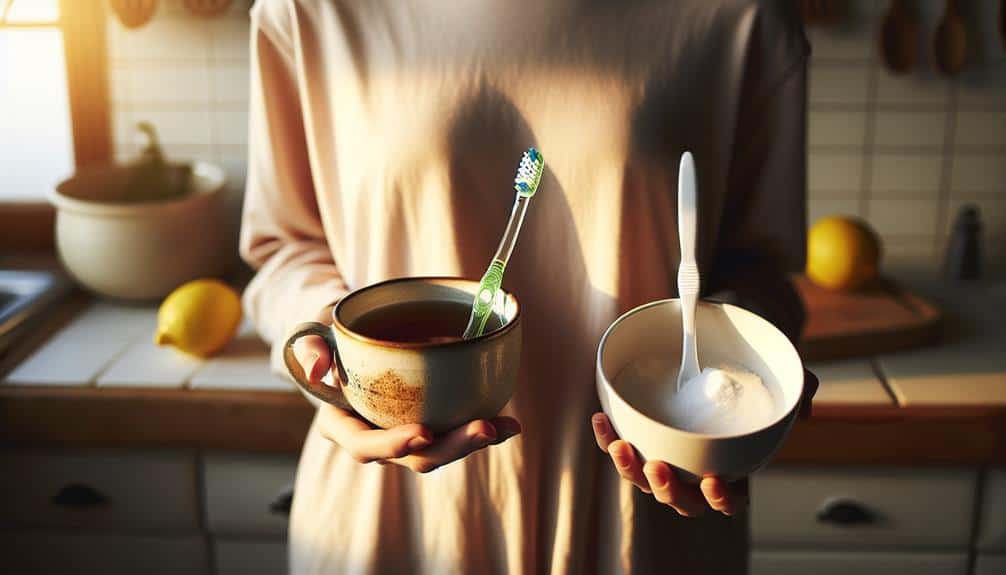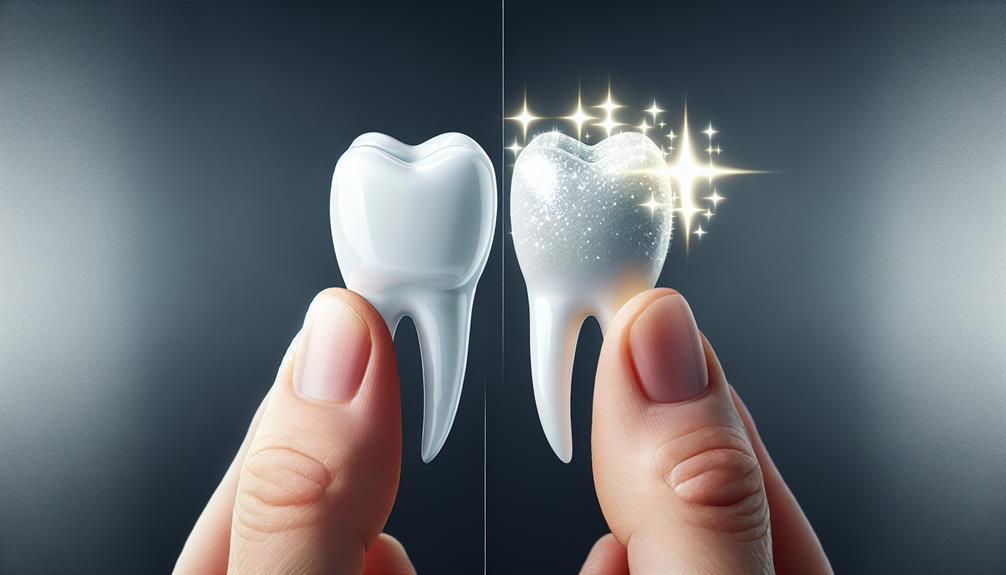For effective tea-stained teeth whitening, consider professional laser treatments that break down stubborn stains quickly. Natural remedies like baking soda, hydrogen peroxide, and coconut oil can also brighten your smile naturally. Opt for whitening toothpaste and mouthwash containing specific ingredients to remove stains. Deep stains may require dental procedures such as laser treatment or enamel restoration. Additionally, making lifestyle changes like limiting tea and coffee intake can prevent further staining. Exploring these methods can lead you to a brighter, more vibrant smile.
Key Points
- Laser treatment by a cosmetic dentist effectively removes stubborn tea stains.
- Natural remedies like baking soda and activated charcoal can whiten teeth at home.
- Whitening toothpaste and mouthwash with specific ingredients help brighten teeth.
- Dental procedures like laser treatment and enamel restoration target deep stains.
- Lifestyle changes, including oral hygiene and diet modifications, can prevent and reduce tea stains.
Professional Whitening Treatments
Looking to achieve a brighter smile through professional whitening treatments? Cosmetic dentistry offers a range of options to help combat tea-stained teeth effectively. One of the most popular methods is laser treatment, which has gained significant traction due to its efficiency and effectiveness in removing stubborn stains caused by tea consumption.
Laser treatments in cosmetic dentistry involve the use of a specialized laser to target and break down the molecules responsible for teeth discoloration. This process is precise, quick, and often yields immediate results, making it a sought-after choice for individuals looking to enhance the brightness of their smile.
When considering professional whitening treatments for tea-stained teeth, consulting with a qualified cosmetic dentist is essential. They can assess the extent of staining, recommend suitable treatment options, and ensure the procedure is performed safely to achieve optimal results.
Natural Remedies at Home
To naturally address tea-stained teeth at home, consider implementing proven remedies that can help effectively whiten your smile. Herbal remedies have been used for centuries to whiten teeth and improve oral health. One such remedy is using a mixture of baking soda and hydrogen peroxide as a gentle abrasive to scrub away stains. Additionally, DIY solutions like activated charcoal can absorb plaque and other compounds that cause discoloration, helping to reveal a brighter smile.
Another popular herbal remedy is oil pulling with coconut oil. This involves swishing coconut oil around in your mouth for about 15-20 minutes to reduce bacteria and promote whiter teeth. Additionally, rubbing the inside of a banana peel on your teeth can also help lift stains due to its high levels of minerals like potassium, magnesium, and manganese.
Incorporating these herbal remedies and DIY solutions into your oral care routine can be a natural and effective way to combat tea-stained teeth from the comfort of your home.
Whitening Toothpaste and Mouthwash
Whitening toothpaste and mouthwash contain ingredients designed to help remove stains and promote a brighter smile. When dealing with tea-stained teeth, these products can be effective in gradually reducing discoloration. Look for toothpaste and mouthwash that specifically mention whitening properties on their packaging. Many of these products contain abrasives or chemicals that work to remove surface stains caused by tea consumption.
To enhance the whitening effects, consider using tea alternatives like green or herbal teas that are less likely to stain teeth. When using whitening toothpaste, apply a pea-sized amount on a soft-bristled toothbrush and brush your teeth in small circular motions for at least two minutes. Make sure to reach all areas of your teeth, including the back molars.
For mouthwash, swish it around your mouth for the recommended time to allow the whitening ingredients to work effectively. Incorporating these products into your oral care routine along with proper brushing techniques can help combat tea stains and brighten your smile over time.
Dental Procedures for Deep Stains
Professional dental procedures offer effective solutions for tackling deep stains that may not respond to traditional whitening methods. One common method is laser treatment, where a dental professional uses a laser to remove deep stains and discoloration from the teeth. This procedure is precise and can target specific areas with accuracy, resulting in noticeable whitening effects.
Enamel restoration is another dental procedure used to address deep stains. This process involves the removal of a thin layer of enamel that contains the deep stains, revealing the whiter, healthier enamel underneath. Enamel restoration can greatly improve the appearance of teeth affected by severe staining, providing a long-lasting solution for deep discoloration issues.
When traditional whitening methods fail to deliver the desired results, consulting with a dental professional about laser treatment or enamel restoration can help you achieve a brighter, whiter smile. These procedures are safe and performed under professional supervision, ensuring effective stain removal and restoring the natural brightness of your teeth.
Lifestyle Changes for Brighter Teeth
For achieving brighter teeth, implementing consistent oral hygiene practices is essential. Diet modifications play a significant role in maintaining a bright smile. Limiting the consumption of tea, coffee, and other strongly pigmented beverages can help prevent further staining. Incorporating more crunchy fruits and vegetables like apples, carrots, and celery can aid in naturally scrubbing away surface stains. Additionally, dairy products rich in calcium and phosphates can strengthen tooth enamel, making it more resistant to discoloration.
In addition to dietary changes, adopting proper oral hygiene habits is vital for achieving and maintaining a brighter smile. Brush your teeth at least twice a day with a fluoride toothpaste and floss daily to remove plaque and prevent stains. Consider using a whitening toothpaste or mouthwash to help lift surface stains gently. Regular dental check-ups and cleanings are also essential to address any underlying issues and keep your teeth healthy and bright. By making these lifestyle changes, you can enhance the whiteness of your teeth and promote overall oral health.
Frequently Asked Questions
Are There Any Specific Types of Teas That Are More Likely to Cause Teeth Staining Than Others?
Tea pigments can stain teeth, with some types like black tea having a higher likelihood. Prevention includes regular brushing and dental cleanings. Green tea, known for its health benefits, may be a better option for those concerned about staining.
Can Using a Straw While Drinking Tea Help Prevent or Reduce Teeth Staining?
Using a straw while drinking tea can be beneficial in reducing teeth staining. Consider tea alternatives like white or green tea. These options are less likely to cause discoloration. Protect your smile and enjoy your tea!
Are There Any Long-Term Effects on Oral Health From Regularly Consuming Tea That Causes Teeth Staining?
Regular tea consumption can lead to enamel erosion and tea stains, affecting oral health. Maintaining good oral hygiene practices, such as brushing and flossing regularly, can help combat these effects. Being mindful of tea's impact on your teeth is crucial.
How Often Should One Consider Getting Professional Teeth Whitening Treatments if They Regularly Drink Tea?
Like a skilled craftsman honing his tools, you should consider professional teeth whitening treatments regularly if you regularly consume tea. To combat tea stains effectively, aim for professional whitening sessions every 6-12 months.
Are There Any Specific Foods or Beverages That Can Help Counteract the Staining Effects of Tea on Teeth?
To counteract tea stains on teeth, consider natural remedies like crunchy fruits and vegetables. These can help scrub away surface stains. Also, use whitening toothpaste for enamel protection. DIY solutions like baking soda can provide gentle whitening benefits.
Conclusion
To sum up, there are various effective methods for tea stained teeth whitening, including:
- Professional treatments
- Natural remedies
- Whitening products
- Dental procedures
- Lifestyle changes
With the right approach, you can achieve a brighter and healthier smile.
So, why wait any longer to take action and regain your confidence with a whiter smile? Trust in these evidence-based methods to help you achieve your teeth whitening goals.



